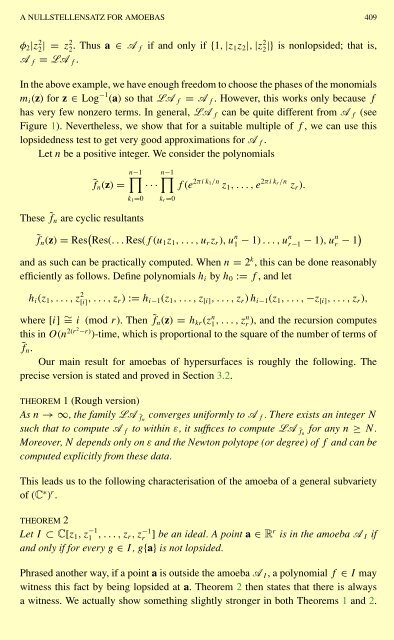A NULLSTELLENSATZ FOR AMOEBAS
A NULLSTELLENSATZ FOR AMOEBAS
A NULLSTELLENSATZ FOR AMOEBAS
Create successful ePaper yourself
Turn your PDF publications into a flip-book with our unique Google optimized e-Paper software.
A <strong>NULLSTELLENSATZ</strong> <strong>FOR</strong> <strong>AMOEBAS</strong> 409<br />
φ 2 |z2 2|=z2 2 . Thus a ∈ A f<br />
A f = LA f .<br />
if and only if {1, |z 1 z 2 |, |z2 2 |} is nonlopsided; that is,<br />
In the above example, we have enough freedom to choose the phases of the monomials<br />
m i (z) for z ∈ Log −1 (a) so that LA f = A f . However, this works only because f<br />
has very few nonzero terms. In general, LA f can be quite different from A f (see<br />
Figure 1). Nevertheless, we show that for a suitable multiple of f , we can use this<br />
lopsidedness test to get very good approximations for A f .<br />
Let n be a positive integer. We consider the polynomials<br />
˜f n (z) =<br />
∏n−1<br />
k 1 =0<br />
These ˜f n are cyclic resultants<br />
···<br />
∏n−1<br />
k r =0<br />
f (e 2πi k 1/n z 1 ,...,e 2πi k r /n z r ).<br />
˜f n (z) = Res ( Res(...Res(f (u 1 z 1 ,...,u r z r ),u n 1 − 1) ...,un r−1 − 1),un r − 1)<br />
and as such can be practically computed. When n = 2 k , this can be done reasonably<br />
efficiently as follows. Define polynomials h i by h 0 := f ,andlet<br />
h i (z 1 ,...,z 2 [i] ,...,z r):= h i−1 (z 1 ,...,z [i] ,...,z r ) h i−1 (z 1 ,...,−z [i] ,...,z r ),<br />
where [i] ∼ = i (mod r). Then ˜f n (z) = h kr (z1 n,...,zn r<br />
), and the recursion computes<br />
this in O(n 2(r2−r) )-time, which is proportional to the square of the number of terms of<br />
˜f n .<br />
Our main result for amoebas of hypersurfaces is roughly the following. The<br />
precise version is stated and proved in Section 3.2.<br />
THEOREM 1 (Rough version)<br />
As n →∞, the family LA ˜f n<br />
converges uniformly to A f . There exists an integer N<br />
such that to compute A f to within ε, it suffices to compute LA ˜f n<br />
for any n ≥ N.<br />
Moreover, N depends only on ε and the Newton polytope (or degree) of f and can be<br />
computed explicitly from these data.<br />
This leads us to the following characterisation of the amoeba of a general subvariety<br />
of (C ∗ ) r .<br />
THEOREM 2<br />
Let I ⊂ C[z 1 ,z −1<br />
1 ,...,z r,zr<br />
−1 ] be an ideal. A point a ∈ R r is in the amoeba A I if<br />
and only if for every g ∈ I, g{a} is not lopsided.<br />
Phrased another way, if a point a is outside the amoeba A I , a polynomial f ∈ I may<br />
witness this fact by being lopsided at a. Theorem 2 then states that there is always<br />
a witness. We actually show something slightly stronger in both Theorems 1 and 2.
















